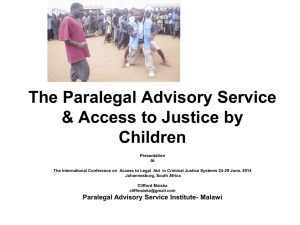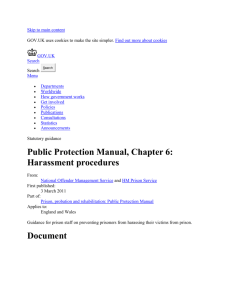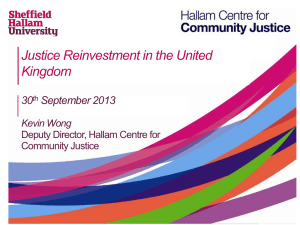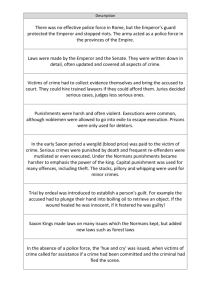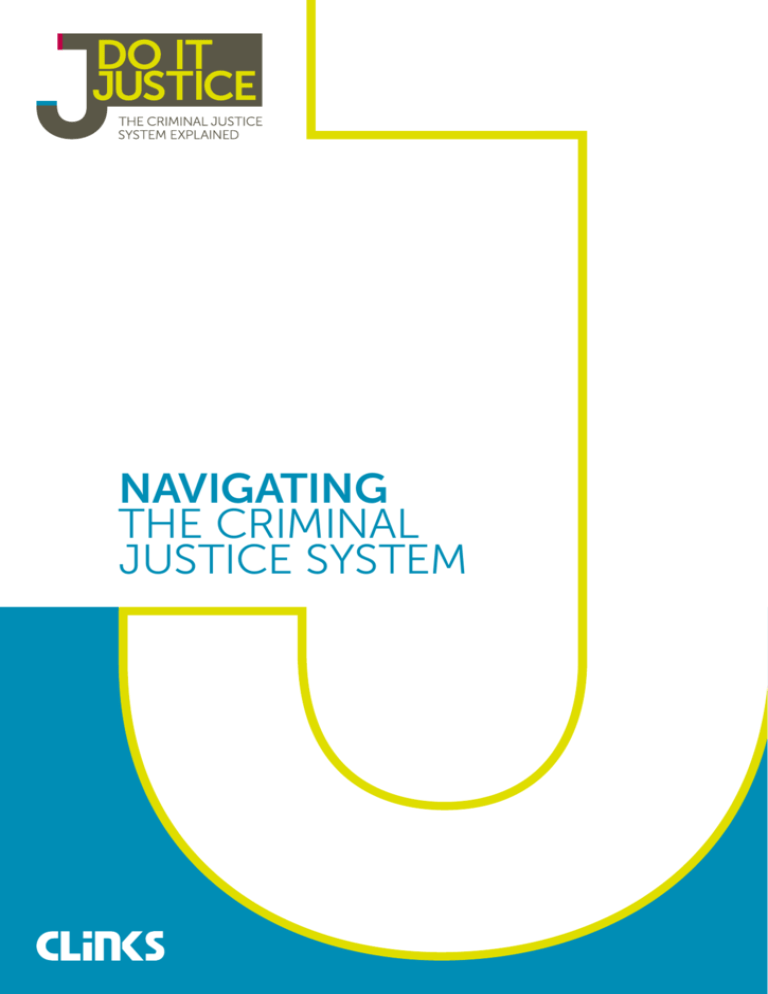
NAVIGATING
THE CRIMINAL
JUSTICE SYSTEM
Acknowledgements
Special thanks are due to the
Ministry of Justice for providing the
funding to undertake this work.
Author
This factsheet was written by
Nathan Dick, Local Development
Team Leader, Clinks.
Feedback or further information
If you have any feedback on the resources,
are seeking further information about the
programme, or would like to share your
own advice/experiences on supporting
the VCS in the Criminal Justice System,
please contact Nathan Dick at Clinks:
nathan.dick@clinks.org
This resource is one of a series called
Do it Justice, aimed at providing
information and advice to the Voluntary
and Community Sector (VCS) on a
range of issues in the Criminal Justice
System (CJS). It provides information
for organisations working in the CJS in
England and Wales. It aims to support
a better understanding of how the
system is organised and how it works.
© Clinks, 2012. All rights reserved.
Unless otherwise indicated, no part of this
publication may be stored in a retrievable
system or reproduced in any form without
prior written permission from Clinks. Clinks will
give sympathetic consideration to requests
from small organisations for permission to
reproduce this publication in whole or in part
but terms upon which such reproduction may
be permitted will remain at Clinks’ discretion.
Clinks and the author are not legally trained
or qualified. Any information or guidance
given in this publication should not be
taken as a substitute for professional legal
advice. Clinks is unable to accept liability
for any loss or damage or inconvenience
arising as a consequence of the use of any
information provided in this guide.
UNPACKING
THE CRIMINAL
JUSTICE SYSTEM
3
A JOURNEY
THROUGH OUR
CRIMINAL JUSTICE
SYSTEM
10
FIND OUT
WHO IS IN
YOUR AREA
11
USEFUL
WEBSITES
11
GLOSSARY
OF TERMS
13
2
Unpacking
the Criminal
Justice System
The Criminal Justice System (CJS) as a whole
can be quite daunting to understand,
because of both its size and its complexity.
However, thinking about it on several levels
makes the task more manageable.
The National
Government
Ministries and
Agencies
Firstly, we will explain the criminal justice
agencies at a national level. This helps us to
understand how local services are managed
and guided by central government, and
where they may have more local autonomy.
The CJS in England and Wales comprises a
number of agencies each responsible to a
government department. The Home Office
takes the policy lead on crime, police, counterterrorism and drugs; all of which impact on wider
Criminal Justice policy. It focuses on community
safety and crime prevention, as well as early
interventions with young people. This includes
oversight of the legislative changes necessary
for the introduction of elected Police and Crime
Commissioners; the first elections will take place
late in 2012. The Ministry of Justice “works to
protect the public and reduce re-offending,
and to provide a more effective, transparent
and responsive criminal justice system for
victims and the public”1. It has responsibility
for Her Majesty’s Prison Service, the Probation
Service, and Her Majesty’s Courts Service.
Secondly, we’ll focus on the local level to
explore some of the statutory services as well
as partnership arrangements with which Local
Support and Development Organisations
(LSDOs) and the Voluntary and Community
Sector (VCS). Being able to understand the
make-up of local criminal justice agencies and
how they interact with each other will affect
an organisation’s ability to effectively support
local VCS organisations, or to support vulnerable
people trying to navigate the local landscape.
Finally, we’ll separate out local CJS
organisations into custodial and
community-based justice services.
On page 4 we have drawn a simplified
diagram of the whole CJS to provide a
snapshot of how different parts inter-relate.
1. Ministry of Justice (2012):
www.justice.gov.uk/
about/moj
The National Offender Management Service
(NOMS) is an executive agency of the Ministry
of Justice which administers HM Prison Service
and the Probation Service for adults (those
over the age of 18) in England and Wales.
NOMS was created in 2008, bringing together
the commissioning and delivery of ‘offender
services’ in custody and the community.
This brings together the headquarters of the
Probation Service and HM Prison Service to
enable more effective and joined-up purchasing
and delivery of services. The two bodies
remain distinct but both share the aims of
carrying out the sentences handed down by
3
THE CRIMINAL
JUSTICE SYSTEM
AT A GLANCE
Home
Office
Directorate of
Policing and Crime
Attorney
General’s
Office
(AGO)
(including anti-social
behaviour, crime, policing,
drugs and alcohol,
community safety)
Police and
Crime
Commissioners
Police
forces
Community
Safety
Partnerships
Youth Justice
Board
(YJB)
National
Offender
Management
Service
(NOMS)
Public and
private
sector
prisons
Crown
Prosecution
Service
Local
government
Health and
Wellbeing
Boards
Ministry
of Justice
Integrated Offender Management
(IOM)
Her Majesty’s
Courts and
Tribunals
Service
Probation
Trusts
Youth
Offending
Services
(YOS)
Youth
Custody
Probation
Local Delivery
Units
Secure
Children’s
Homes
Young
Offender
Institutions
Secure
Training
Centres
Magistrates
Court
Crown
Court
Cross-cutting local partnership and/or delivery structures
Integrated Offender
Management (IOM)
4
Local Criminal Justice Boards (LCJB)
Locally developed networks
courts, protecting the public, and reducing
re-offending by tackling the causes of crime.
NOMS published a document called ‘How the
National Offender Management Service works’2
(March 2012) which provides a good overview
of their structure, staffing and responsibilities.
2. NOMS (2012) – How
the National Offender
Management System
works: www.justice.gov.uk/
downloads/about/noms/
noms-org-chart.pdf
3. Magistrates are mainly
trained volunteers who
preside over cases, normally
in groups of three, that are
often thought to be less
serious than those passed
up to the Crown Court.
Magistrates can become a
member of the Magistrates
Association which seeks
“... to promote the sound
administration of the law by
educating and instructing
magistrates and others in
the law, the administration
of justice, the treatment
of offenders and the best
methods of preventing crime;
and promoting discussion on
developments in the law and
the administration of justice”.
4. The CPS will advise the
police on possible cases
for prosecution, determine
charges in all but very minor
cases, prepare cases for court
and present cases to court.
The Youth Justice Board (YJB) is an executive
non-departmental public body which oversees
the youth justice system (for young people under
the age of 18) in England and Wales whose board
members are appointed by the Secretary of
State for Justice (see the board members here).
The YJB provides strategic guidance and has
corporate responsibility for ensuring the Youth
Justice System fulfils its strategic objectives. It
has responsibility for ensuring that the custodial
settings for young people are safe, secure and
address the causes of their offending behaviour.
The YJB provides guidance, support and
information for practitioners in Youth Offending
Teams and others working with young offenders.
Her Majesty’s Courts and Tribunals Service was
created in April 2011 to bring together HM Courts
Service and Tribunals Service into a single agency,
to support the administration of justice in courts
and tribunals. There are a number of different
courts that hear different cases. All cases are
initially heard by magistrates3, some are dealt
with there and others referred on to Crown Court.
Some less serious offences can only be seen by
the Magistrates Court, others can be heard in
either court, and some offences are so serious
they can only be dealt with by the Crown Court.
Magistrates are mainly volunteers who have
been trained and have the support and advice
of legally qualified court clerks. However, there
are also a number of stipendiary magistrates,
who are professional lawyers, and usually sit on
their own to hear cases in some of the busier
courts. Judges sit primarily in the Crown Court
and are usually qualified barristers who have
been appointed to the judiciary, but some
may also be solicitors. The Courts and Tribunal
Service have provided a ‘court finder’ service so
that you can identify where your local court is.
The Attorney General’s Office (AGO) provides
legal and strategic policy advice to the Attorney
General and Solicitor General. The Attorney
General is in turn Chief Legal Advisor to the
Crown and a Minister, with the responsibility
of overseeing the Crown Prosecution Service –
which is the government department responsible
for prosecuting criminal cases.4 Amongst other
things the AGO has responsibility for referring
sentences to the Court of Appeal, questions issues
of contempt of court, and intervenes in the public
interest in certain charity and family law cases.
Independent Inspectorates and Commissions
exist for a number of the criminal justice
agencies. Their function is to carry out
independent inspections and investigations into
the conduct of these agencies and/or institutions
to protect the rights and dignity of people who
may be engaged, affected or involved with them.
These bodies produce public reports which
are used to improve and reform the system as
well as highlight good practice. They include:
• Her Majesty’s Inspectorate of Constabulary
• Independent Police Complaints Commission
• Her Majesty’s Crown Prosecution
Service Inspectorate
• Her Majesty’s Inspectorate of Prisons
• Her Majesty’s Inspectorate of Probation.
5
LOCAL STATUTORY
Agencies
This section has been divided into community
based services and custodial (prison) services.
Some voluntary groups only work in one
of these settings, although it is increasingly
common that organisations work across
both, especially when helping people
resettle into the community from prison.
In the Community
The Police are providers of community safety.
Their role is to uphold the law, to prevent crime, to
pursue and bring to justice those who break the
law, and to protect and reassure the community.
The Police are the first point of contact for people
entering the CJS. They are also a potential point
of diversion away from the CJS. Police forces
should be engaged with local community
organisations to jointly reduce criminal or
antisocial behaviour and activity. You can find links
to your local Police Force by visiting the police.uk
website to more locally specific information.
Police personnel are supported and advised
by a number of bodies such as the Association
of Chief Police Officers (ACPO) and the Police
Federation who both act as representative
bodies to provide strategic guidance on the
shape of policing alongside government.
Police and Crime Commissioners (PCC) will
be elected for the first time in November
2012 and will replace what was the Police
Authority. This change to the CJS was brought
6
about by the passing of the Police Reform and
Social Responsibility Act 2011, in September
2011.5 The PCC is an elected official and as
such is answerable to the public. Their role
will not be to run the police, but to hold
them to account. They will have oversight
of a five year policing and crime plan which
will attempt to reduce crime and improve
community safety over a geographical area.
To access more detailed information on the PCC
you can also visit Clinks’ Safer Future Communities
(SFC) website, which provides a range of
resources and briefings. Furthermore NAVCA,
as part of the SFC partnership, has established a
number of local networks to support the voice
and representation of the VCS in the run up to
the election of PCCs. Further details of these
networks can be found on the Clinks website.
Community Safety Partnerships (CSP) are
hosted by the local authority and it is their
responsibility to bring together key criminal
justice partners to discuss and inform ways in
which crime can be reduced at a local level. There
are approximately 310 CSPs across England and
Wales. Their contact details can be found here
on the Community Safety Partnerships section of
the Home Office website. The CSP holds a small
amount of funding for local initiatives, and is a
good place for VCS organisations to lobby for
local action to address issues of crime and justice.
Local Criminal Justice Boards (LCJB) are locally
created forums within which partnerships of local
CJS agencies can collaborate and bring forward
strategic plans for a local area, including a longterm strategic plan. The LCJBs will normally
comprise of representatives from the Police,
5. Police Reform and Social
Responsibility Act 2011:
www.legislation.gov.uk/
ukpga/2011/13/contents/
enacted/data.htm
6. ‘On licence’ or ‘on parole’
means being released
from prison before your
sentence is finished, and
being supervised by the
Probation Service.
7. For more detailed
information on what
a pre-sentence report
includes visit: www.cps.
gov.uk/legal/p_to_r/
provision_of_pre_sentence_
report_information
8. The Probation Service
works with other public,
private and voluntary
organisations to provide
support to victims as
well as helping offenders
with accommodation,
employment and education,
drug treatment, and debt
advice. The Probation
Service also lead on MultiAgency Public Protection
Arrangements (MAPPA) for
their area, this is a system
for managing convicted
dangerous offenders
in the community.
9. To find your local YOT visit:
www.justice.gov.uk/global/
contacts/yjb/yots/index.htm
Crown Prosecution Service, HM Courts and
Tribunal Service, HM Prison Service, Probation
Trust, and the Youth Offending Service.
or sentence, while other approved premises are
run by externally contracted organisations. They
also provide services to the victims of crime.
The Northumbria Criminal Justice Board is
one such example. LCJBs can be a positive
motivator for local partnership development,
for example, in 2011 the NCJB worked alongside
the Newcastle Council for Voluntary Service
to host four training sessions on how the LCJB
could improve their partnership working with
the VCS. Information on these training sessions
can be found in the training pilot section of the
Northumbria Criminal Justice Board website.
The Probation Service is divided into Trusts
which operate across a broad geographical area,
often covering a number of local authorities
but differing in size from area to area.
The current Government’s Localism agenda
means there will be increased autonomy at a
local level. Some areas have looked into the
possibility of merging local partnership structures
such as the LCJBs and the aforementioned CSPs.
Youth Offending Services (YOSs) work with
offenders between the ages of 10 and 17
years. There is a YOS in every local authority
in England and Wales. The YOS is accountable
to the local authority and is funded from
a range of sources, including the Criminal
Justice System, the Youth Justice Board, local
authorities and other government departments,
to support the safety of young people and
their physical and mental wellbeing.9
The Probation Service supervises people
over the age of 18 who have been given a
community order by the courts, or who have
been released from prison on licence.6 They
occupy a unique position because they work
in the courts, community, and in prisons.
The Probation Service provides the courts with
pre-sentence reports (PSRs)7 about the offence
and the person accused of it. They deliver
what is often called ‘offender management’,
including the supervision of people on licence,
as well as sometimes offering more flexible
local interventions, for example supporting
people on their release from prison back into
the community.8 They provide some of the
approved premises (or hostels) for offenders
with a residence requirement on their licence
The Probation Trust oversees Local Delivery
Units (LDUs) which cover a much smaller area
and provide the aforementioned services
through local offices – there is an assistant
chief officer with responsibility for each LDU.
YOSs consist of representatives from
the police, probation service, social
services, health, education, drugs and
alcohol misuse and housing officers.
The main delivery vehicle for YOS is the
Youth Offending Team (YOT) which is locally
managed and is responsible for co-ordinating
the work of the youth justice services.
Integrated Offender Management (IOM) is
described by the Ministry of Justice as: “a system
that provides all agencies engaged in local criminal
7
justice partnerships with a single coherent structure
for the management of repeat offenders”.10
Since 2009, IOM arrangements have been
introduced in every local area across England and
Wales. They typically bring together staff from all
the agencies engaged in local CJS partnerships:
Police, Probation, Prisons, and other key statutory
and VCS organisations. Their collective aim is
to reduce reoffending by the most prolific/
repeat offenders in the local community. This
includes those released after serving prison
sentences of less than twelve months who
are not currently subject to any statutory
supervision by their local Probation Trust.
IOM is seen as having the potential to become
a ‘hub’ of partnership activity focused on
reducing reoffending in local areas.
Clinks have produced a number of resources to
encourage VCS engagement in IOM11 as well as a
series of resources exploring the potential role of
the VCS in IOM.12 These provide useful guidance
as to how the VCS can play a role in IOM schemes.
In custody
HM Prison Service (HMPS) consists of 142
prisons in England and Wales. Most are run by
the Public Sector, and the rest are contracted
out to the Private Sector. You can search for a
local prison and find a list of contracted-out
prisons on the Ministry of Justice website.
Most prisons in either sector are for adult males.
There are currently 13 Women’s prisons with
four juvenile units and seven mother and baby
units.13 Women represent approximately 5% of
8
the prison population and typically go to prison
for different offences and often in very different
circumstances to their male counterparts.
A review by Baroness Corston of the women’s
justice system was published in 2007.14 It set
out recommendations for change which
are still being championed by the VCS by
organisations like Women’s Breakout.
Depending on the length of sentence and the
type of offence, prison regimes may include
opportunities for training, education, drug
treatment, and help with resettlement back into
the community. Some services in prisons, like
Visitor’s Centres, are nationally commissioned
and procured, while other services will vary
from prison to prison. In those cases, VCS
engagement is largely dependent on the
relationship between local organisations and
the Prison’s senior management team.
Prisons are broadly categorised according
to the level of security each provides.
Category A Prisons
Category A prisons (the High Security Estate),
hold those prisoners considered to be the
most dangerous, serving long sentences
for ‘Serious offences’. Category A prisoners
are those that would pose the most threat
to the public, criminal justice agencies,
or national security should they escape.
Therefore, Category A prisons have extremely
high levels of security to prevent escape.
Category B prisons
Category B prisons will hold people serving long to
medium length sentences who are deemed less of
10. Ministry of Justice
(2011) – What we do: our
responsibilities: www.
justice.gov.uk/about/
moj/what-we-do/ourresponsibilities.htm#ghi
11. Clinks (2011): www.
clinks.org/services/
localism-work/iom
12. Clinks (2012) – A series
of guides supporting
VCS involvement in
IOM arrangements
can be found at: www.
clinks.org/publications/
reports/iom-resources
13. Read more about the
Women’s prison estate
here: www.justice.gov.
uk/offenders/typesof-offender/women
14. Home Office (2007): The
Corston Report, a review
of women with particular
vulnerabilities in the Criminal
Justice Systen. See: www.
clinks.org/assets/files/
PDFs/Corston-pt-1.pdf
a risk (in comparison to Category A) to the public,
criminal justice agencies, or national security. They
often present a lower risk of potential escape.
15. Prisoners serving longer
than 12 months are called
‘statutory offenders’ and
there is a statutory duty
for the Probation Service
to provide them with
supervision after release
to ensure their licence
conditions are fulfilled
(the person will receive
different licence conditions
depending on the severity
of the offence committed,
the length of the sentence
served and the perceived risk
of harm the person poses to
the public, and their needs).
The prison staff will liaise
with the Probation Service
in the prisoner’s home
area to provide support
where possible. However,
those serving less than 12
months are called ‘nonstatutory offenders’ and
do not receive supervision
or support upon release
from the probation service.
Many VCS services providing
support to individuals in
prison highlight the need
to provide support for this
vulnerable client group.
16. You can find your local
YOI here: www.justice.gov.
uk/global/contacts/yjb/
young-offender-institutionscontact-details.htm
17. There are currently four
Secure Training Centres in
England and Wales. Details
of the STCs are here: www.
justice.gov.uk/global/
contacts/yjb/secure-trainingcentres-contact-details.htm.
18. You can find your local
SCH by looking here: www.
justice.gov.uk/global/
contacts/yjb/securechildrens-homes-contactdetails.htm or you can visit
the Secure Accommodation
Network (SAN) for a
directory of homes and
best practice guidelines.
Some Category B prisons partly or wholly
function as remand prisons, holding prisoners
in pre-trial detention. A significant proportion
of the people in remand prisons may be there
for a very short period of time.15 Category
B prisons that contain remanded prisoners
are sometimes also known as ‘Local Prisons’.
Prisoners serving sentences of less than 12
months often remain in remand or local prisons.
Category C and D prisons
Category C (training) prisons and Category D
(open) prisons hold people who are less of a
risk to the public and present a much lower risk
of escape. The prisoners will almost always be
nearing the end of their sentence by the time
they are transferred to a Category D prison.
These prisons will often be more focused on
resettlement, with most prisoners coming to the
end of their sentence and preparing for release
back into the community. This will include the
opportunity for prisoners to leave prison under
ROTL (Release on Temporary Licence) that allows
them to undertake voluntary work placements
or can allow for overnight visits to relatives.
Regularly-updated and authoritative
information on the prison estate can be
found in the Bromley Briefings, produced
by the Prison Reform Trust and funded by
the Bromley Trust. This is an indispensable
source of information on the issues affecting
people in prison as well as the changing
operational circumstances facing prisons.
Secure accommodation for
Young People
The Youth Justice System has a number of
different options at their disposal to place
young people in secure accommodation. This
ranges from Her Majesty’s Young Offender
Institutions (YOI), Secure Training Centres and
Secure Children’s Homes. In the same way as
the adult estate, these are run by providers
from both the private and statutory sectors.
Young Offender Institutions
Young Offender Institutions (YOIs)16 are
designed for offenders aged 18 to 20, but can
in some instances hold juvenile offenders,
or those aged 15-17. A YOI can be a standalone institution, but in some instances is colocated within the grounds of an adult prison.
When this is the case, the young and adult
offenders themselves are always separated.
Secure Training Centres
There are a small number of Secure Training
Centres (STCs),17 all of which are run by
private companies. The Youth Justice
Board purchases places for children.
STCs hold boys and girls aged 12-17.
Secure Children’s Homes
Secure Children’s Homes (SCHs)18 are all
run by local authorities. The Youth Justice
Board can purchases places for boys and/
or girls aged 10-17. SCHs range in size from
six to 40 beds and have the highest staff to
child ratio in the children’s secure estate.
9
A journey
through our
Criminal Justice
System
FROM ARREST
TO CONVICTION
The flowchart opposite gives a brief overview
of a typical offender journey through the
Criminal Justice System from the point of
arrest up until their conviction or release. This
provides a snapshot of the system an individual
has to navigate before they are sentenced.19
Almost all criminal cases begin with an offence
being reported to the police, who may, after
investigating, charge a person with an offence
if they believe there is sufficient evidence for
the Crown Prosecution Service to secure a
conviction. At this stage the decision is made on
remand: whether it is safe to release the suspect
on bail, or whether they must be kept in custody
pending the trial. This decision is made by
magistrates, based on information provided by
the defence solicitor and the Crown Prosecutor.
19. Citizens Advice provide a good summary of the rights that the individual has when in the Criminal Justice System, these can
be found here: www.adviceguide.org.uk/index/your_rights/legal_system_index_ew/police_powers.htm
10
FIND OUT
WHO IS IN
YOUR AREA
Photo © Duncan Phillips | www.reportdigital.co.uk
USEFUL
WEBSITES
R
O
F
G
N
I
LOOK
T?
R
O
P
P
U
S
You need the Working With Offenders Directory!
Information on hundreds of organisations
providing services to offenders can be found
on Clinks’ Working With Offenders Directory,
which is a directory of services to offenders.
These services can be searched by subdivisions:
by whether they work in the community
or in custody; by geographical location; by
service type; by the specific offender group
targeted; or by any combination of the above.
VCS organisations may register their details in
the Directory for free. For further information
or enquiries visit the Clinks website.
Clinks Links
Clinks has a comprehensive links section on
our website. This provides a range of advice
and guidance for organisations working in the
Criminal Justice System. It also references other
mainstream support services that may be of use.
Visit the Clinks website to see what available.
Action for Prisoners Families
Action for Prisoners Families (APF) works
for the benefit of prisoners’ and offenders’
families by representing the views of families
and those who work with them, and by
promoting effective work with families.
www.prisonersfamilies.org.uk
Centre for Crime and Justice Studies
The Centre for Crime and Justice Studies
is an independent public interest charity
whose mission is to inspire enduring change
by promoting greater understanding of
social harm, the centrality of social justice
and the limits of criminal justice.
www.crimeandjustice.org.uk
Clinks
Clinks supports the Voluntary and Community
Sector working with offenders in England and
Wales. Our aim is to ensure the Sector and
all those with whom it works, are informed
and engaged in order to transform the lives
of offenders and their communities.
www.clinks.org
Criminal Justice Alliance
The Criminal Justice Alliance (CJA) is a coalition
of organisations – including campaigning
charities, voluntary sector service providers,
research institutions, staff associations and trade
unions – involved in policy and practice across
the Criminal Justice System. It disseminates
information, organises meetings, and supports
its members to work together. The Criminal
Justice Alliance also campaigns - on behalf
of and with its members – for a fairer and
more effective criminal justice system.
www.criminaljusticealliance.org
11
Howard League for Penal Reform
The Howard League for Penal Reform is the oldest
penal reform charity in the world. It was established
in 1866 and is named after John Howard, one of
the earliest prison reformers. The Howard League
provides some legal services for vulnerable
people, is involved in a range of parliamentary
lobbying work, and has a research function.
www.howardleague.org
Offenders’ Families Helpline
The Offenders’ Families Helpline provides
information for families who have come into contact
with the Criminal Justice System as a result of a
family member’s offending behaviour. As well as
the helpline for service users the website provides
good quality information to better understand
the CJS from arrest to release from prison.
www.offendersfamilieshelpline.org
Prison Reform Trust
Prison Reform Trust (PRT) is an independent UK
charity working to create a just, humane and
effective penal system. PRT inquire into the
workings of the criminal justice system; prepare
publications to inform prisoners, staff and the
wider public; and by influence Parliament,
government and officials towards reform.
www.prisonreformtrust.org.uk
Restorative Justice Council
The Restorative Justice Council (RJC) provides
quality assurance and a national voice in the field of
restorative justice practice. The RJC is the independent
third sector membership body consisting of
practitioners, training providers, and RJ organisations
around the country. The RJC also provides advice
and consultancy, enabling new services to grow.
www.restorativejustice.org.uk
12
T2A Alliance
T2A (Transition to Adulthood) Alliance is a broad
coalition of organisations and individuals. It
identifies and promotes more effective ways
of working with young adults, who often fall
between the cracks in the transition from
youth to adult services in the Criminal Justice
System, as well as in other service areas
such as mental health, homelessness, drug
and alcohol treatment, and employment.
Convened by the Barrow Cadbury Trust, its
membership encompasses leading criminal
justice, health and youth organisations.
www.t2a.org.uk
Victim Support
Victim Support is the national charity giving
free and confidential help to victims of crime,
witnesses, their family, friends and anyone
else affected across England and Wales. They
also speak out as a national voice for victims
and witnesses, and campaign for change.
www.victimsupport.com
Women’s Breakout
Women’s Breakout is the representative body
for a national network of women-centred
services offering effective gender-specific
community alternatives to custody. Women’s
Breakout exists to shape national approaches
working with vulnerable women who are in
contact with or at risk of becoming involved
with the Criminal Justice System. Women’s
Breakout provides a point of contact for
consultation for a wide range of statutory and
voluntary sector organisations interested in
researching and evaluating the integrated,
women’s community service model of working.
www.womensbreakout.org.uk
GLOSSARY
OF TERMS
ACO
ACPO
AGO
ASSET
ATB
BAME
CO
CDRP
CPS
CRB
CRC
CSP
CTC
CVS
DAAT
DIP
DRR
DTTO
ETE
ETS
HM
HMPS
HMI
IAC
ISSP
IMB
IOM
IPPC
LCJB
MAPPA
NOMS
OASys
OLASS
PBA
PCC
PCT
Assistant Chief Officer, Probation
Association of Chief Police Officers
Attorney General’s Office
Youth Justice needs assessment tool
Attitudes, Thinking and Behaviour
Black, Asian, Minority Ethnic
Chief Officer, Probation
Crime and Disorder Reduction Partnership
Crown Prosecution Service
Criminal Records Bureau
Criminal Records Check
Community Safety Partnership
Counter Terrorism Check
Council for Voluntary Services
Drugs and Alcohol Team
Drug Intervention Programme
Drug Rehabilitation Requirement
Drug Treatment and Testing Order
Education, Training and Employment
Education, Training and Skills
Her Majesty’s
Her Majesty’s Prison Service
Her Majesty’s Inspectorate
Intensive Alternative to Custody
Intensive Supervision and
Surveillance Programme
Independent Monitoring Boards
Integrated Offender Management
Independent Police
Complaints Commission
Local Criminal Justice Board
Multi-agency Public
Protection Arrangements
National Offender Management Service
Offender Assessment Systems
Offender Learning and Skills Service
Probation Boards’ Association
Police and Crime Commissioner
Primary Care Trusts
PPO
PSR
RoTL
SFA
SPO
VCS
YOT
Prolific and Priority Offenders
Pre-Sentence Reports
Release on Temporary Licence
Skills Funding Agency
Senior Probation Officer
Voluntary and Community Sector
Youth Offending Team
13
Clinks
59 Carter Lane
London
EC4V 5AQ
020 7248 3538
info@clinks.org
www.clinks.org
Clinks is a registered charity no. 1074546 and a company
limited by guarantee registered in England no. 3562176.


